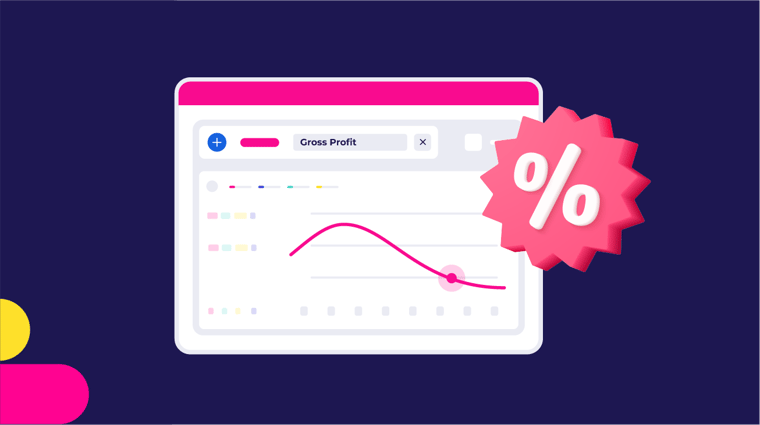Discounting is a common and effective strategy used by retail businesses to attract customers, boost sales, and increase brand loyalty. However, when not executed strategically, discounting can lead to over-discounting, negatively impacting profit margins and eroding the perceived value of products.
To address these challenges, marketing data can play a vital role in helping retailers make informed decisions about when, where, and how to implement discounts. By leveraging marketing data such as ad spend per stock keeping unit (SKU) and using commercial data, businesses can find the right balance between driving sales and maintaining healthy profit margins.
The pitfalls of over-discounting

While discounts can drive short-term sales spikes, they can also be a double-edged sword. Over-discounting, which involves offering excessively high discounts too frequently, can lead to several issues:
1. Profit margins erosion:
A significant concern with over-discounting is that it reduces the profit margin on products. This can be particularly harmful when applied to products that already have narrow margins, cutting into profits even further.
This is particularly true for products restricted by seasonality and those which may become obsolete due to technological advancements.
2. Reduced perceived value:
Frequent and steep discounts can devalue a brand in the eyes of consumers. When shoppers grow accustomed to discounts, they might be less willing to pay the full price in the future, leading to a detrimental impact on brand equity.
3. Inventory issues:
If discounts are not adequately planned and managed, they can lead to inventory imbalances. Over-discounting might result in excess inventory for discounted products while non-discounted items face scarcity.
How to leverage marketing data for smarter discounting
To avoid the pitfalls of over-discounting, businesses can turn to marketing data as a powerful tool to enhance their discounting strategies.
Here are some ways marketing data, such as ad spend per SKU, can be utilised:
1. Analyse historical data:
Examining past discount campaigns and their impact on sales and profit margins can provide valuable insights. Businesses can identify patterns and trends to determine which discounts were most effective and which led to negative consequences.
2. Segment customer data:
Marketing data allows businesses to segment their customer base according to various criteria like demographics, buying behaviour, and preferences. This segmentation enables targeted discounting, tailoring offers to specific customer groups, increasing the likelihood of success.
However, new customer data is harder to come by due to stricter consumer privacy laws coming into place, meaning marketers need to find other ways to focus their efforts.
3. Promote new arrival products:
There is a limited window when products can be sold for full price. As a new product, it doesn’t yet have data, so algorithms (which are intrinsically risk averse), choose not to promote these items right away.
For example, people generally buy sandals between May and June, and after that they start thinking about autumn attire. This gives a window of only 1.5-2 months when people are open to buying the product for the full price.
If a retailer relies on the algorithms to promote the sandals with other products in a single product set, they will get less attention because the algorithm knows nothing about them. By the time Meta and Google algorithms gather enough learnings about the sandals to promote them at full force, they are nearly at the end of their full price window. This means they must be discounted to get sold, and the retailer has lost margin. Apply this to all new arrival products with a short full-price window, and the lost margin quickly adds up.
A product performance management (PPM) platform enables retailers to apply an age filter to create a separate product set or group of items recently added to the catalogue, ensuring their new arrivals receive promotion right off the bat.
.png?width=1118&height=496&name=Sn%C3%ADmek%20obrazovky%202023-08-15%20v%2013.41.33%20(1).png)
4. Increase marketing budget before discounting
Merchandisers often apply discounts with the assumption that the product must be too expensive because it's not selling. However, they’re lacking data; the true reason it’s not selling may actually be because algorithms simply aren’t promoting it.
Using product performance data, retailers can easily find which products aren’t getting promoted and which products are being promoted, but just aren’t selling.
By knowing the difference, retailers can take the step to increase their marketing budget around those items to ensure the products are being promoted before they decide to lose margin by discounting items that haven’t even been seen by customers yet.
If retailers utilise the money they’d lose from discounting to instead promote the product, then the probability they’ll get a new customer is bigger – and that's the trick behind how Shein is growing so fast.
To prioritise marketing budget instead of discounting, retailers need an interface like a PPM platform where merchandisers and marketers collaborate to find which products are poor-performers and need discounting, and which products actually just need a marketing budget boost to finally get promoted.
The role of commercial data in promotional decision-making

While marketing data aids in refining discounting strategies, commercial data can complement the decision-making process by helping businesses understand which products to promote and which to avoid promoting due to reduced profit margins from discounting.
Commercial data encompasses information related to the financial aspects of products and their performance:
1. Product profitability:
Analysing commercial data can reveal the profitability of each product in the lineup. By understanding which products have higher profit margins, marketers can prioritise their promotional efforts accordingly.
2. Sales performance:
Commercial data offers insights into how different products are performing in the market. Identifying top-selling items can help marketing teams focus on promoting products that have been proven to be popular, increasing the chances of success.
3. Inventory levels:
Maintaining a healthy inventory balance is crucial to avoid overstocking or stockouts. Commercial data can provide visibility into inventory levels, enabling businesses to make data-driven decisions about discounting to optimise inventory turnover.
4. Competitive analysis:
Understanding how competitors are pricing and promoting their products is vital in the dynamic market landscape. Commercial data can aid in conducting competitive analysis, which helps businesses devise strategies to stay ahead in the market.
Final takeaway
Incorporating marketing data and commercial data into discounting and promotional decision-making processes can significantly improve outcomes for businesses. Avoiding over-discounting preserves profit margins and upholds the perceived value of products, while strategic discounting enhances customer loyalty and drives sales.
By leveraging the power of marketing and commercial data through a product performance management (PPM) platform, businesses can strike the right balance between discounts and profits, leading to sustainable growth and success in a competitive market.
Are you interested in learning how to balance discounts for profitability during the holiday season?



.png)
